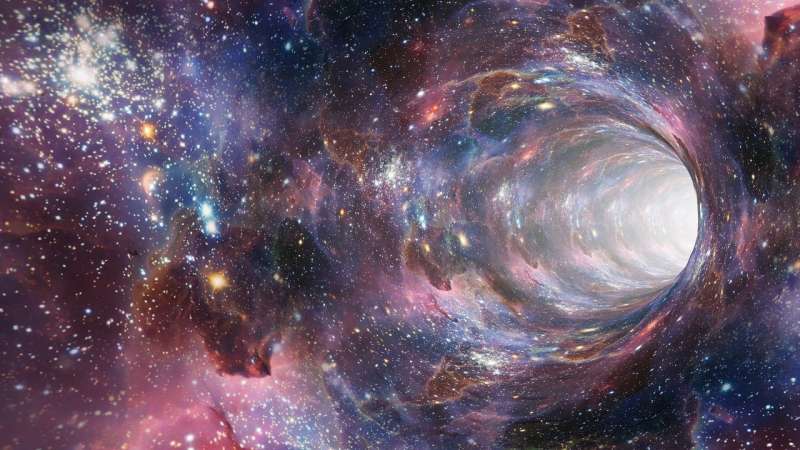August 1, 2024 dialog
This article has been reviewed according to Science X's editorial process and policies. Editors have highlighted the following attributes while ensuring the content's credibility:
fact-checked
peer-reviewed publication
trusted source
written by researcher(s)
proofread
A higher-dimensional model can help explain cosmic acceleration without dark energy

Dark energy remains among the greatest puzzles in our understanding of the cosmos. In the standard model of cosmology called the Lambda-CDM, it is accounted for by adding a cosmological constant term in Einstein's field equation first introduced by Einstein himself. This constant is very small and positive and lacks a complete theoretical understanding of why it has such a tiny value. Moreover, dark energy has some peculiar features, such as negative pressure and does not dilute with cosmic expansion, which makes at least some of us uncomfortable.
Therefore, physicists keep looking for alternative explanations for cosmic acceleration. Earlier, in a paper titled "On the accelerated expansion of the universe," published in the journal Gravitation and Cosmology, I explained that if the universe exists in pair with an anti-universe running backwards in time, we can explain this cosmic acceleration without dark energy.
In my new work, which is the braneworld model, i.e., our universe, which is a 3-brane immersed in some higher dimensional bulk, I could do away with the elusive dark energy, which I elaborate now.
My new model and results
In this model, I start with a braneworld scenario where our universe is itself a part of some higher dimensional bulk. Think of it like a 2D sheet floating in 3D space. These lower dimensional structures are called branes, and each brane has some constant brane tension—T—which plays a role in its dynamics. I used a variable tension brane model and also simultaneously promoted the 4D Newton's constant G to a scalar field while keeping the 5D Newton's constant coming from the bulk to be fixed.
To make us comfortable, some modified gravity theory, such as Brans-Dicke's theory, also promotes Newton's constant G to a scalar field. This led to the dynamics, which mimics the standard Friedmann equation, but now the scalar field G effectively plays the role of matter fields in our universe while matter effectively plays the role of dark energy. It is effective in the sense that I am now considering the combined effect coming from the variable brane tension too.
Therefore, without using any cosmological constant term, I was able to explain dark energy with only two known fields: scalar field G, which is 4D Newton's constant but is now promoted to a scalar field and matter field. We considered radiation to be negligible, which is a good approximation of our universe. The results are published in the journal Europhysics Letters.
After working on the problems of dark matter and dark energy, I can say that either we accept that general relativity is correct and we live in a dark universe with these elusive and peculiar dark matter particles and dark energy, or we accept that we live in a higher dimensional multiverse.
Regarding modified gravity theories, it does not appeal to me that Nature will select a law that keeps varying with distance(as frequently claimed by proponents of modified gravity theories such as MOND) or else that will undermine the definition of law itself. My intuition and experience suggest that nature prefers beauty, simplicity and symmetry, and modified gravity theories simply do not meet these criteria.
On the scientific side, it remains with observations to determine the truth, which hopefully we will know someday, given the scientific advancement we have made so far.
This story is part of Science X Dialog, where researchers can report findings from their published research articles. Visit this page for information about ScienceX Dialog and how to participate.
More information: Naman Kumar, Variable brane tension and dark energy, Europhysics Letters (2024). DOI: 10.1209/0295-5075/ad233f . On Arxiv: arxiv.org/abs/2404.17941
Journal information: Europhysics Letters (EPL) , arXiv
Kumar is a doctoral student at IIT Gandhinagar, India, working under the supervision of Dr. Arpan Bhattacharyya. Kumar's research areas include general relativity, cosmology, Braneworld theory and spacetime thermodynamics.




















